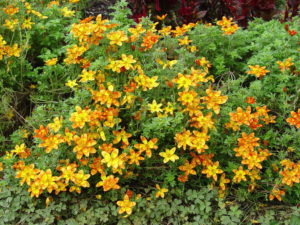Bidens
* Common name: Bidens or fern-leaf beggarticks

Bidens Bidy Boom Bonfire
* Botanical name: Bidens ferulifolia
* What it is: Despite being a native of the Southwestern U.S., this mini-marigold look-alike is not very well known and seldom planted. That might be changing now that breeding has introduced some new, compact, and brilliantly colored varieties, such as Goldilocks Rocks, Campfire Flame, ‘Bidy Boom Bonfire,’ and the Taka Tuka series.
These cut-leafed, annual flowers grow in a foot-tall mound and bloom all summer in bicolor blends, most often in shades of red, orange, and/or gold. Plants also look a bit like coreopsis, to which they’re related.
Being native, flowers are attractive to native pollinators, but deer don’t like them at all.
* Size: Plants grow 12 to 14 inches tall. Plant 15 to 18 inches apart when grown in a grouping.
* Where to use: Bidens do best in sunny, well drained locations. They’re ideal in south- or west-facing foundation or garden beds… also edging walks or around a mailbox. And they do well in pots and hanging baskets.
* Care: Plant transplants after all danger of frost in spring (i.e. mid to late May). Keep soil consistently damp the first few weeks, then water needed only once or twice a week in very hot, dry spells.
Work compost and timed-release flower fertilizer into soil at planting. Supplemental liquid flower fertilizer every month or so throughout the growing season maximizes bloom but isn’t required.
Deadheading and snipping also usually aren’t needed for the newer, compact varieties.
Yank and compost plants when frost kills them in fall. Just use gloves because the little seeds are barbed and can jag.
* Great partner: Holly, dwarf Hinoki cypress, or any green or gold-tinted evergreen is a good shrub partner. Bidens look natural next to most any ornamental grass as well. Or pair with red annuals, such as celosia or geraniums, or with red-blooming perennials, such as hardy hibiscus or daylilies.







